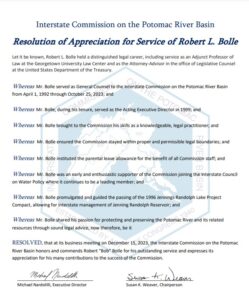News from Around the Basin – January 25, 2024
Moving the Needle on the Bay Barometer
ICPRB is just one of many organizations working together to improve the health of the Chesapeake Bay watershed. The Chesapeake Bay Program recently released the Bay Barometer, which takes a look at the progress we have made towards the 18 outcomes set forth in the Chesapeake Bay Watershed Agreement.
There is some good news. Oyster habitat, public access points, and protected lands are on-course for their restoration targets.
ICPRB’s stream health index, Chessie BIBI, also provides positive news, with the report noting that between 2012 and 2017, 67.8% of stream miles in the watershed were considered healthy, marking a 6% increase since the previous assessment period.
Learn about Chessie BIBI and explore the interactive map on ICPRB’s website >>>
Recording of ICPRB’s Webinar on Agriculture
On January 19, 2024, ICPRP hosted a webinar with speakers from Devereux Consulting and the National Association of Conservation Districts to cover the impacts that agricultural land use has on water quality in the Potomac basin and funding opportunities available to mitigate these effects.
The recording and presentations can be found on ICPRB’s website >>>





